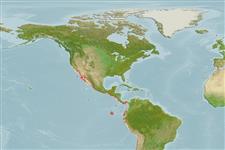分類 / Names
俗名 | 同種異名 | Catalog of Fishes(屬, 種) | ITIS | CoL | WoRMS | Cloffa
Teleostei >
Syngnathiformes (Pipefishes and seahorses)
海龍目 (Pipefishes and seahorses) >
Syngnathidae (Pipefishes and seahorses)
海龍科 (Pipefishes and seahorses) > Syngnathinae
Etymology: Hippocampus: Greek, ippos = horse + Greek,kampe = curvature (Ref. 45335).
More on author: Girard.
Environment: milieu / climate zone / depth range / distribution range
生態學
海洋 礁區魚類; 非遷移的; 深度上下限 0 - 60 m (Ref. 30915), usually 3 - 18 m (Ref. 5227). 亞熱帶的; 37°N - 22°S, 123°W - 70°W
Eastern Pacific: confirmed records from San Diego in California, USA to Peru including the Galapagos Islands.
Reported from the San Francisco Bay by Alexander Agassiz (Ron Fritzsche, pers.comm. 08/09).
東太平洋: 在包括加拉巴哥群島的美國加州到祕魯的聖地牙哥。 國際間的買賣被監視過一個授權系統 ( 引用2, 自從 5.15.04 以後) ,而且一個 10 公分的最小大小應用。
Length at first maturity / 大小 / 重量 / 年齡
Maturity: Lm 5.4 range ? - ? cm
Max length : 30.0 cm TL 雄魚/尚未辨別雌雄; (Ref. 2850)
簡短描述
檢索表 | 型態特徵 | 形態測量圖
背棘 (總數) : 0; 背的軟條 (總數) : 18 - 21.
描述: (以 19件標本為依據): 成魚的高度: 13.0-19.0 公分。 環: 11+39(38-40)
吻的長度: 2.3-2.4(2.1-2.5) 分之一頭長。 背鰭鰭條: 19(18-21)個覆蓋 2+1個環。 胸鰭鰭條: 16.(15-17) 冠: 中等的-高的, 傾斜向後有五個在頂端很清晰點,銳利的邊緣或邊緣。 棘: 可變的, 從低的圓形腫塊到發展良好的頂端鈍的棘。 其他的顯著特性: 突出的﹐長的 (下垂), 圓的, 單一頰的棘; 突出的眼棘;(可能是寬或幾乎兩倍) 雄性通常有一個突出的龍骨脊; 性成熟雌性時常在臀鰭之下有一個深色的小區塊。
彩色斑紋: 淡紅的-褐紅色的﹐灰色的﹐和黃色的與黃金; 各種不同的有褐色陰影; 垂直地跑的細白淡色與深色的斑紋墬落身體可能。
Nocturnal. Occur in offshore waters, mostly captured by dredging at 10 m or deeper. Occasionally caught at surface. Are often camouflaged within the branches of gorgonians and black coral trees where they are seen to curl their tail around the branches (Ref. 5227). Have been found in the stomachs of Pacific yellowfin tuna and bluefin tuna (Ref. 30915). Ovoviviparous (Ref. 205). The male carries the eggs in a brood pouch which is found under the tail (Ref. 205).
夜行的。 出現在離岸水域, 大部份捕獲藉由在 10 公尺或更深地拖撈網。 在表面偶而捕獲。 時常在柳珊瑚的樹枝與黑珊瑚樹裡面被偽裝在那裡它們被見到樹枝的周圍捲曲他們的尾部.(參考文獻 5227) 曾經發現於太平洋黃鰭鮪魚與藍鰭鮪魚的腹部。 (參考文獻 30915) 卵胎生的.(參考文獻 205) 雄魚帶卵在一個孵卵袋是在尾部下面發現.(參考文獻 205)
Life cycle and mating behavior
成熟度 | 繁殖 | 產卵場 | 卵 | 孕卵數 | 仔魚
Male carries the eggs in a brood pouch (Ref. 205). Gestation period is 14-15 days depending on temperature (Ref. 30915).東太平洋: 在包括加拉巴哥群島的美國加州到祕魯的聖地牙哥。 國際間的買賣被監視過一個授權系統 ( 引用2, 自從 5.15.04 以後) ,而且一個 10 公分的最小大小應用。
Lourie, S.A., R.A. Pollom and S.J. Foster, 2016. A global revision of the seahorses Hippocampus Rafinesque 1810 (Actinopterygii: Syngnathiformes): taxonomy and biogeography with recommendations for further research. Zootaxa 4146(1):1-66. (Ref. 115213)
IUCN 瀕危狀態 (Ref. 130435: Version 2024-2)
人類使用
漁業: 商業性; 水族館: 商業性
工具
特別的報告
下載 XML
網路資源
Estimates based on models
Preferred temperature (Ref.
123201): 19.1 - 28.5, mean 24.3 °C (based on 131 cells).
Phylogenetic diversity index (Ref.
82804): PD
50 = 0.5000 [Uniqueness, from 0.5 = low to 2.0 = high].
Bayesian length-weight: a=0.00447 (0.00175 - 0.01142), b=2.99 (2.77 - 3.21), in cm total length, based on LWR estimates for this (Sub)family-body shape (Ref.
93245).
營養階層 (Ref.
69278): 3.3 ±0.38 se; based on food items.
回復力 (Ref.
120179): 高度, 族群倍增時間少於 15個月 (tm=0.3-0.4).
Fishing Vulnerability (Ref.
59153): Low vulnerability (20 of 100).
Nutrients (Ref.
124155): Calcium = 71.1 [33.9, 167.8] mg/100g; Iron = 1.28 [0.60, 2.43] mg/100g; Protein = 18.7 [17.3, 20.0] %; Omega3 = 0.164 [0.069, 0.364] g/100g; Selenium = 32.1 [12.6, 86.2] μg/100g; VitaminA = 22.8 [5.6, 102.3] μg/100g; Zinc = 1.08 [0.61, 1.78] mg/100g (wet weight);
